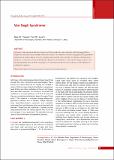Please use this identifier to cite or link to this item:
https://hdl.handle.net/20.500.14356/1975Full metadata record
| DC Field | Value | Language |
|---|---|---|
| dc.contributor.author | Roka, Y B | - |
| dc.contributor.author | Thapa, R | - |
| dc.contributor.author | Puri, P R | - |
| dc.contributor.author | Aryal, S | - |
| dc.date.accessioned | 2023-06-04T09:08:08Z | - |
| dc.date.available | 2023-06-04T09:08:08Z | - |
| dc.date.issued | 2011 | - |
| dc.identifier.citation | RokaY. B., ThapaR., PuriP. R., & AryalS. (2011). Van Gogh Syndrome. Journal of Nepal Health Research Council. https://doi.org/10.33314/jnhrc.v0i0.261 | en_US |
| dc.identifier.issn | Print ISSN: 1727-5482; Online ISSN: 1999-6217 | - |
| dc.identifier.uri | http://103.69.126.140:8080/handle/20.500.14356/1975 | - |
| dc.description | Case Study | en_US |
| dc.description.abstract | Abstract Self injury is the intentional and direct injury to self that include bite, burn, ulceration and head banging. These injuries are rarely fatal and are usually not suicidal in nature. This behavior is common among adolescents, psychiatric patients and in females. Bipolar disorder, drug abuse and metabolic syndromes like LeschNyhan and Munchausen’s syndrome are often associated with this disorder. Repetitive self mutilation is termed the Van Gogh syndrome after the famous painter who cut off his ear and gave it to a prostitute. We describe two such cases of self mutilation in schizophrenic patients. Keywords: bipolar disorder, psychiatry, self mutilation, Van Gogh syndrome | en_US |
| dc.language.iso | en | en_US |
| dc.publisher | Nepal Health Research Council | en_US |
| dc.relation.ispartofseries | April;261 | - |
| dc.subject | Bipolar disorder | en_US |
| dc.subject | Psychiatry | en_US |
| dc.subject | Van Gogh syndrome | en_US |
| dc.subject | Self mutilation | en_US |
| dc.title | Van Gogh Syndrome | en_US |
| dc.type | Journal Article | en_US |
| local.journal.category | Case Study | - |
| Appears in Collections: | Vol 9 No 1 Issue 18 April 2011 | |
Files in This Item:
| File | Description | Size | Format | |
|---|---|---|---|---|
| 261-Article Text-259-1-10-20130822.pdf | Fulltext Download | 555.07 kB | Adobe PDF |  View/Open |
Items in DSpace are protected by copyright, with all rights reserved, unless otherwise indicated.
